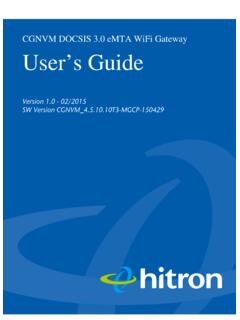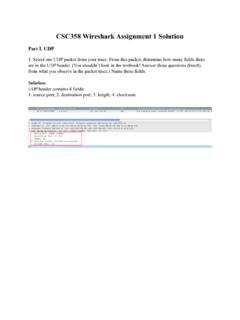Transcription of Fundamentals Of Computer Networking ... - Purdue University
1 Fundamentals Of ComputerNetworking And InternetworkingProf. Douglas ComerPurdue Universityhttp:// www . cs . Purdue . edu/ people / comer Copyright 2014 by Douglas Comer And Pearson Education. All rights IIntroductions, Course Overview,Approaches To Networking , Open AndClosed Systems, Protocols, And LayeringComputer Networks and Internets -- Module 11 Spring, 2014 Copyright 2014. All rights Networks and Internets -- Module 12 Spring, 2014 Copyright 2014. All rights And ScopeComputer networks and internets: an overview of concepts,terminology, and technologies that form the basis for digitalcommunication in individual networks and the global InternetComputer Networks and Internets -- Module 14 Spring, 2014 Copyright 2014. All rights Will LearndFundamental principlesdConceptsdTerminology (lots of it)dKey aspects of networkingComputer Networks and Internets -- Module 15 Spring, 2014 Copyright 2014. All rights Five Key Aspects Of NetworkingdData communications: signals over wires and bits oversignalsdNetworks: packets over bitsdInternets: datagrams over packetsdNetwork programming: application data over the InternetdCross-functional concepts and technologies: networkconfiguration, control, and managementComputer Networks and Internets -- Module 16 Spring, 2014 Copyright 2014.
2 All rights Of The CoursedCoversallof Networking and internetworking from media toapplicationsdExamines each of the underlying technologiesdFocuses on concepts and principles that apply acrossvendors and productsdProvides perspective and shows how the pieces fit togetherdExplains how an Internet is built from heterogeneousnetworksComputer Networks and Internets -- Module 17 Spring, 2014 Copyright 2014. All rights You Will Not LearndCommercial aspects Vendors Products Prices Markets and marketingdHow to engineer network equipmentdHow to configure / operate networksdHow to design new protocolsComputer Networks and Internets -- Module 18 Spring, 2014 Copyright 2014. All rights Sessions (Aka Labs)dForm an important part of the coursedYou will Build network programs Capture and analyze packets Learn about protocolsComputer Networks and Internets -- Module 19 Spring, 2014 Copyright 2014. All rights ExpecteddOur goal is breadth rather than depthdOnly a few basics are needed Ability to program in C A glancing acquaintance with data structures andpointers A minor brush with algebra A basic understanding of operating systemsdThe major requirement is a desire to learnComputer Networks and Internets -- Module 110 Spring, 2014 Copyright 2014.
3 All rights Of The CoursedExplores all aspects of Networking and internetworkingdGives concepts and principlesdFocuses on the big picturedIncludes lots of programming exercisesdMoves rapidly and covers lots of vocabularyComputer Networks and Internets -- Module 111 Spring, 2014 Copyright 2014. All rights ApproachesTo NetworkingHow Should A Network Be Structured? Computer Networks and Internets -- Module 114 Spring, 2014 Copyright 2014. All rights Should A Network Be Structured?dThe early phone company answer Data Networking is like telephone calls We will devise and offer various data services Charges will depend on distance and duration You only need 128 KbpsComputer Networks and Internets -- Module 114 Spring, 2014 Copyright 2014. All rights Should A Network Be Structured?dThe early phone company answer Data Networking is like telephone calls We will devise and offer various data services Charges will depend on distance and duration You only need 128 KbpsdThe early Computer vendor answer A network connects computers in your organization We will devise all the necessary equipment and software You only need to connectourcomputers You only need to runourapplicationsComputer Networks and Internets -- Module 114 Spring, 2014 Copyright 2014.
4 All rights Should A Network Be Structured?(continued)dThe early network equipment vendor answer The network is independent of computers We will create network equipment and interfacehardware that connects computers to our network We will build device drivers for your operating system You only need to useournetworkComputer Networks and Internets -- Module 115 Spring, 2014 Copyright 2014. All rights Resulting Commercial Network SystemsdApple ComputerAppletalkdBanyanVinesdDigital Equipment CorporationDECNETdIBMSNAdNovellNetwaredU ngermann BassNET / OnedXeroxXNSC omputer Networks and Internets -- Module 116 Spring, 2014 Copyright 2014. All rights Researcher s AnswerdAlthough we have computers at multiple sites, we reject thephone company s approachdBecause we use diverse Computer architectures, we rejectthe Computer vendors approachdBecause a variety of network technologies are possible, wereject the network vendors approachdA variety of applications are possibledLet s experiment with new technologies (short distance aswell as long distance) and new applicationsComputer Networks and Internets -- Module 117 Spring, 2014 Copyright 2014.
5 All rights Resulting Research ProjectsdXerox Palo Alto Research Center EthernetdMIT and elsewhere Token passing ring networksdDepartment of Defense ARPANET SATNET Packet radio net Theglobal InternetComputer Networks and Internets -- Module 118 Spring, 2014 Copyright 2014. All rights Vs. Closed NetworkingdClosed networks Vertical approach Each vendor designs / builds their own Given technology owned by vendor Vendor may license technology to other groupsdOpen networks Competitive approach Multiple groups collaborate to define a technology To insure interoperability, specifications written instandardsdocuments that are available to everyone Companies build products according to standardsComputer Networks and Internets -- Module 119 Spring, 2014 Copyright 2014. All rights StandardsAnd protocol DesignWhy Standardize?dNetworking supports communication among multipleentitiesdAgreement needed to make communication correct, efficient,and meaningfulComputer Networks and Internets -- Module 122 Spring, 2014 Copyright 2014.
6 All rights Organizations Issue Standards?dIEEE (Institute of Electrical and Electronics Engineers)dIETF (Internet Engineering Task Force)dITU (International Telecommunications Union)dISO (International Organization for Standardization)dW3C (World Wide Web Consortium) many othersComputer Networks and Internets -- Module 123 Spring, 2014 Copyright 2014. All rights And StandardizationdJoke: why is Networking so difficult? Computer Networks and Internets -- Module 124 Spring, 2014 Copyright 2014. All rights And StandardizationdJoke: why is Networking so difficult?dBecause there are so many standards from which to chooseComputer Networks and Internets -- Module 124 Spring, 2014 Copyright 2014. All rights how to handle one aspect ofcommunicationdA protocol can specify Low-level details such as voltage and frequency High-level details such as format visible to a userdMany individual communication protocol standards existdSet of protocols designed to work together is known as asuite Example: TCP / IP Internet protocol suiteComputer Networks and Internets -- Module 125 Spring, 2014 Copyright 2014.
7 All rights Key Properties That Protocols SpecifydSyntax Format of each message Representation of data items Encoding of bits in electromagnetic signalsdSemantics Meaning of each message Procedures used to exchange messages Actions to take when an error occursComputer Networks and Internets -- Module 126 Spring, 2014 Copyright 2014. All rights In protocol DesigndLook at the facilities the underlying hardware providesComputer Networks and Internets -- Module 127 Spring, 2014 Copyright 2014. All rights In protocol DesigndLook at the facilities the underlying hardware providesdImagine an abstract communication mechanism as a userwould like it to workComputer Networks and Internets -- Module 127 Spring, 2014 Copyright 2014. All rights In protocol DesigndLook at the facilities the underlying hardware providesdImagine an abstract communication mechanism as a userwould like it to workdDesign an efficient implementation of the abstractionComputer Networks and Internets -- Module 127 Spring, 2014 Copyright 2014.
8 All rights In protocol DesigndLook at the facilities the underlying hardware providesdImagine an abstract communication mechanism as a userwould like it to workdDesign an efficient implementation of the abstractiondThe key to success:choose a good abstractionComputer Networks and Internets -- Module 127 Spring, 2014 Copyright 2014. All rights protocol Design Is DifficultdMultipleimplementationsof a protocol will existdImplementations will be created by a multipleindividuals/organizationsdThere are many details to considerdKey tradeoff A specification that dictates all possible details restrictsimplementations A specification that does not specify enough details isambiguous and leads to incompatible implementationsComputer Networks and Internets -- Module 128 Spring, 2014 Copyright 2014. All rights InteroperabilitydDesign principle that maximizes interoperability (due toPostel)Be conservative in what you sendand be liberal in what you Networks and Internets -- Module 129 Spring, 2014 Copyright 2014.
9 All rights Layeringand Layering ModelsProtocol LayeringdNeeded because communication is complexdIntended primarily for protocol designersdDivides communication into intellectually manageablepiecesdProvides a conceptual framework that can help usunderstand protocolsdIdeally, layering is invisible once protocols have beendesigneddNotes: Layering gives a guideline, not a rigid framework Optimizations may violate strict layeringComputer Networks and Internets -- Module 131 Spring, 2014 Copyright 2014. All rights Layering ModelsdInternet protocols use a 5-layer reference modeldISO and the ITU defined a 7-layer modelComputer Networks and Internets -- Module 132 Spring, 2014 Copyright 2014. All rights Layering ModelsdInternet protocols use a 5-layer reference modeldISO and the ITU defined a 7-layer modelComputer Networks and Internets -- Module 132 Spring, 2014 Copyright 2014. All rights Reference ModelApplicationTransportInternetNetwork InterfacePhysicalLAYER 1 LAYER 2 LAYER 3 LAYER 4 LAYER 5dDescriptive model formed after TCP / IP protocols weredeviseddUsed in practiceComputer Networks and Internets -- Module 133 Spring, 2014 Copyright 2014.
10 All rights LayerdUnderlying transmission mediadElectromagnetic energy and its usedRepresentation of information in signalsdElectrical properties such as radio frequencies and voltagedAssociated hardwareComputer Networks and Internets -- Module 134 Spring, 2014 Copyright 2014. All rights Interface LayerdCommunication between a Computer and network hardwaredAlso calleddata linkorMAClayerdMechanisms for gaining access to shared mediadHardware (MAC) addressingdPacket (frame) formatsdPacket (frame) types and demultiplexingdError detectionComputer Networks and Internets -- Module 135 Spring, 2014 Copyright 2014. All rights LayerdCommunication between a pair of computers across theInternetdInternet packet format (datagram)dInternet addressing model and address assignmentdForwarding of Internet packetsdDividing an Internet packet into smaller packets fortransmissiondError detection and reportingComputer Networks and Internets -- Module 136 Spring, 2014 Copyright 2014.



